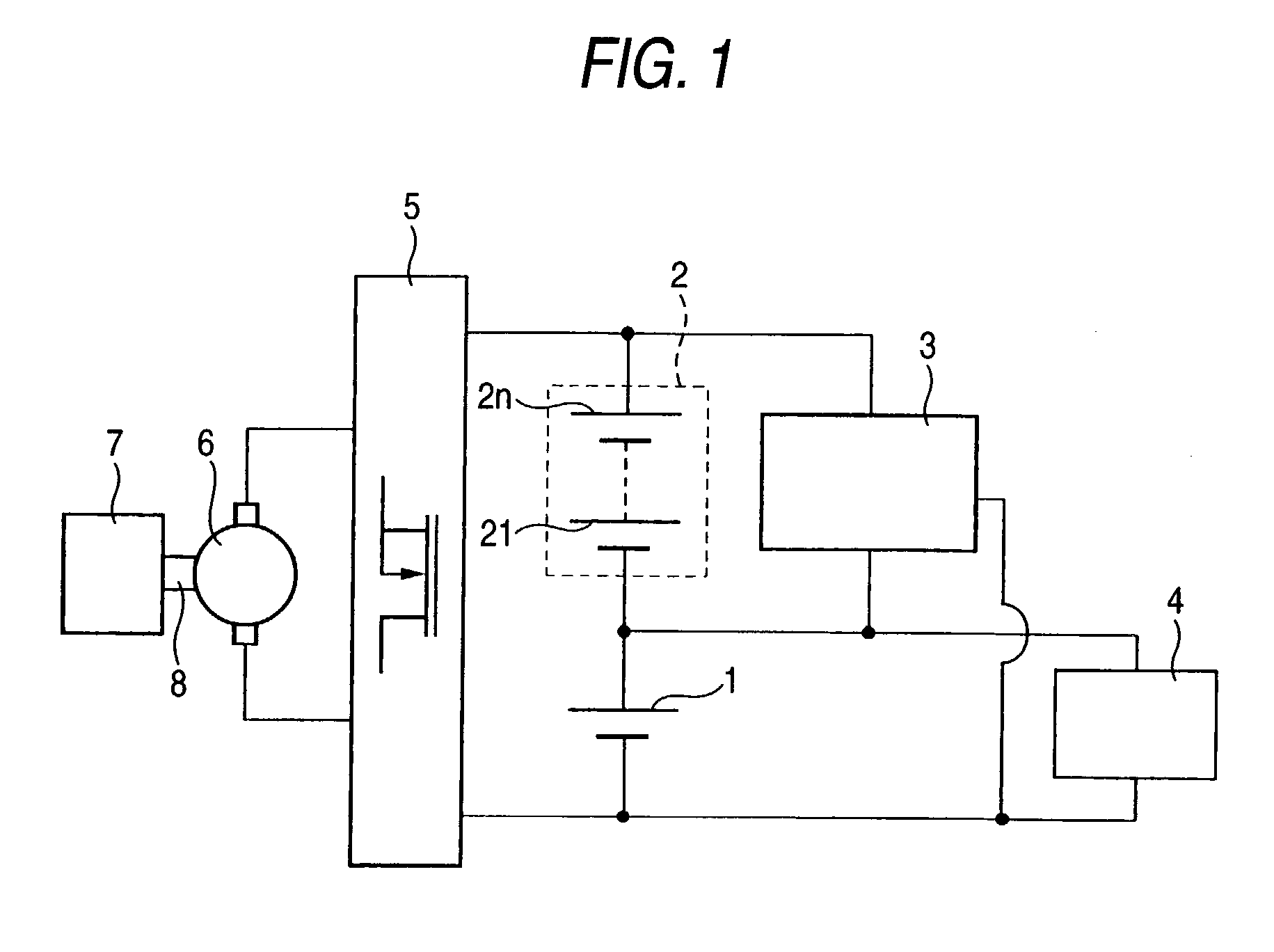Battery power circuit and automobile battery power circuit
a battery power circuit and battery technology, applied in the direction of electric variable regulation, process and machine control, instruments, etc., can solve the problems of power circuits being expensive, power conversion circuits 5 becoming expensive, and further increasing costs
- Summary
- Abstract
- Description
- Claims
- Application Information
AI Technical Summary
Benefits of technology
Problems solved by technology
Method used
Image
Examples
embodiment 1
[0039] (Embodiment 1)
[0040] FIG. 1 shows the configuration of an automobile battery power circuit according to Embodiment 1 of the invention. A battery group 1 (first battery group) and a battery group 2 (second battery group) are connected in series. The reference numeral 3 represents a DC / DC converter inserted between the battery group 1 and the battery group 2; 4, a load connected to the battery group 1; 5, a power conversion circuit connected to the opposite ends of the series body of the battery group 1 and the battery group 2; 6, an electric motor connected to the power conversion circuit 5; 7, an engine; and 8, a power transmitter for transmitting power between the electric motor 6 and the engine 7. Here, for example, the battery group 1 is constituted by one battery having a rated voltage of 12 V, and the battery group 2 is constituted by n batteries having a rated voltage of 12 V, that is, batteries 21 to 2n. The DC / DC converter 3 is connected among the opposite ends of the...
embodiment 2
[0044] (Embodiment 2)
[0045] FIG. 2 shows the configuration of an automobile battery power circuit according to Embodiment 2 of the invention. The automobile battery power circuit in FIG. 2 is different from that in FIG. 1 in that a cell motor 10 is connected to the battery group 1 through a key switch 9 for initial start-up. Only the initial start-up requiring high power is performed by the cell motor 10. As a result, electric power is supplied to the electric motor 6 through the power conversion circuit 5 so as to start the engine 7 only when the engine 7 is warmed up, so that the capacity of the power conversion circuit 5 can be reduced as described in the related art. A cell motor power transmitter 11 is used to start the engine 7 by means of the cell motor 10. In order to lead the engine 7 to a predetermined number of revolutions by means of the limited power of the cell motor 10, torque conversion may be performed using a belt, gears, or the like, in the cell motor power transm...
embodiment 3
[0046] (Embodiment 3)
[0047] FIG. 3 is a diagram showing the configuration of an automobile battery power circuit according to Embodiment 3 of the invention. The automobile battery power circuit in FIG. 3 is different from that in FIG. 2 in that the batteries of the battery group 2 are replaced by capacitors. That is, the battery group 2 is formed as a capacitor group 20 constituted by a series body of capacitors 201-20n. As described in Embodiment 2, the capacity of the battery group 2 may be low when the load 4 has a low capacity. Accordingly, not batteries but capacitors can satisfy the specifications sufficiently in some cases. Particularly, of capacitors, electric double layer super capacitors, electrolytic capacitors, or the like, can be used because they can secure high capacitance. Thus, the batteries 21-2n are removed so that the lives of parts can be expected to be longer on a large scale.
PUM
 Login to View More
Login to View More Abstract
Description
Claims
Application Information
 Login to View More
Login to View More - R&D
- Intellectual Property
- Life Sciences
- Materials
- Tech Scout
- Unparalleled Data Quality
- Higher Quality Content
- 60% Fewer Hallucinations
Browse by: Latest US Patents, China's latest patents, Technical Efficacy Thesaurus, Application Domain, Technology Topic, Popular Technical Reports.
© 2025 PatSnap. All rights reserved.Legal|Privacy policy|Modern Slavery Act Transparency Statement|Sitemap|About US| Contact US: help@patsnap.com



